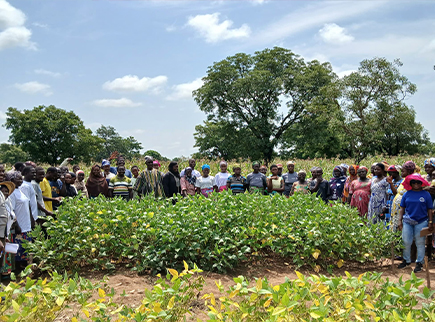The Soybean Breeding Team of the Council for Scientific and Industrial Research-Savanna Agricultural Research Institute (CSIR-SARI), has held an on-farm demonstration at Salaga to bridge the gap between research and the adoption of improved soybean varieties by farmers.
The exercise formed part of CSIR-SARI’s efforts to involve farmers in the development, testing and selection of new soybean lines to ensure that research output addressed farmers’ practical needs.
It was also to help the farmers to understand good agronomic practices, identify high pod clearance, high yielding and early maturing lines suitable for their conditions and encourage the use of improved technologies to increase productivity and sustainability.
The demonstration featured both mother and baby trials, with the mother trial managed by the researchers to showcase improved agronomic practices such as row planting, proper spacing, fertilizer application and other good agronomic practices.
Farmers were also given seed packages for their own baby trials to compare the new soybean lines with their traditional varieties.
Over the years, many farmers in the area faced challenges such as low yields, poor soil fertility, and pest attacks due to limited fertilizer use, poor planting methods, and poor plant populations use, hence the demonstration farm, for them to learn practical ways to improve production and soil management.
Dr Ophelia Asirifi Amoako, Agronomist and Senior Research Scientist at CSIR–SARI, speaking during the event in the East Gonja Municipality of the Savannah Region, explained that it formed part of a new approach known as Participatory Varietal Selection (PVS), which allowed farmers to be directly involved in evaluating and selecting improved lines developed by researchers.
She said the approach sought to ensure that new varieties met the needs and preferences of farmers.
Through the PVS, farmers were given the opportunity to evaluate, rank and score the lines based on traits such as yield, pod size, early maturity, pod clearance, plant vigour and biomass, drought tolerance and resistance to pests and diseases.
Dr Amoako said most farmers did not apply fertilizer to their soybean farms and often failed to follow proper agronomic practices such as row planting and spacing.
Dr Charles Nelimor, Research Scientist and Soybean Breeder at CSIR-SARI, said the team leveraged the platform to showcased good planting practices and introduced two innovative soybean lines: one featuring high pod clearance for mechanized harvesting and another with early maturity traits to enhance resilience against climate change-induced rainfall variability.
Dr Francisca Addae-Frimpomaah, Head, Soybean Breeding Team at CSIR–SARI, said the expectation was that after farmers made their selections based on yield, maturity, height, pod clearance, and other desired traits, they would identify the lines they were most willing to adopt.
She emphasized that the goal was not to develop varieties that remained on research shelves, but to ensure that farmers cultivated and benefited from them once released.
She said involving farmers in the process helped them understood the traits of the new lines and the reasons they should consider planting them when they became available on the market.
Dr Addae-Frimpomaah appealed to the government to consider reversing the ban on soybean exports, explaining that the restriction had made it difficult for farmers to sell their produce since bulk buyers, who used to export, no longer came to purchase from them.
She said lifting the ban would help create a market for farmers and motivate them to expand production.
Mr Osman Suleman, a farmer, who also supported the SARI group in managing the field activities, described the exercise as very important for the community, saying it helped farmers understand improved methods, which could boost yields even on smaller farms.
He said the demonstration motivated many farmers to adopt the new practices after witnessing the visible results on the field.
Mr Suleman identified harvesting as a significant challenge for soybean farmers, saying manual harvesting of large farms often resulted in delays and substantial post-harvest losses, indicating that the introduction of high pod clearance lines offered timely solution, which would enable farmers to utilize mechanized harvesters and streamline their harvesting process
He appealed to CSIR–SARI, Ministry of Food and Agriculture, the government and other stakeholders to support farmers with mechanization, especially planters and harvesters to make production more efficient.
Other farmers observed visible differences between the new lines and their local varieties, noting better growth, healthier plants, high pod clearance, and improved pod formation.

